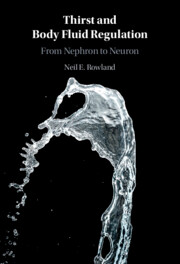Book contents
- Thirst and Body Fluid Regulation
- Thirst and Body Fluid Regulation
- Copyright page
- Contents
- Figures
- Preface
- 1 Fundamentals of Thirst and Body Fluid Regulation
- 2 Body Fluid Compartments, Inputs, and Outputs
- 3 Intracellular Dehydration Thirst and Drinking
- 4 Intracellular Dehydration: Mechanism
- 5 Extracellular Dehydration Thirst and Drinking
- 6 Pregnancy and the Ontogeny of Thirst
- 7 Food-Associated Drinking and Nycthemeral Rhythms
- 8 Hybrid Dehydrations: Water Deprivation
- 9 Hybrid Dehydrations: Thermal Stress and Exercise
- 10 Thirst in Aging and Clinical Populations
- 11 Comparative Aspects of Body Fluid Regulation
- Appendix Methods in Physiology and Neuroscience
- References
- Index
7 - Food-Associated Drinking and Nycthemeral Rhythms
Published online by Cambridge University Press: 09 December 2021
- Thirst and Body Fluid Regulation
- Thirst and Body Fluid Regulation
- Copyright page
- Contents
- Figures
- Preface
- 1 Fundamentals of Thirst and Body Fluid Regulation
- 2 Body Fluid Compartments, Inputs, and Outputs
- 3 Intracellular Dehydration Thirst and Drinking
- 4 Intracellular Dehydration: Mechanism
- 5 Extracellular Dehydration Thirst and Drinking
- 6 Pregnancy and the Ontogeny of Thirst
- 7 Food-Associated Drinking and Nycthemeral Rhythms
- 8 Hybrid Dehydrations: Water Deprivation
- 9 Hybrid Dehydrations: Thermal Stress and Exercise
- 10 Thirst in Aging and Clinical Populations
- 11 Comparative Aspects of Body Fluid Regulation
- Appendix Methods in Physiology and Neuroscience
- References
- Index
Summary
In free-feeding animals, including humans, most daily water consumption is prandial, occurring during or soon after meals. In contrast to earlier interpretations, it now appears that this drinking has a systemic basis and is not purely anticipatory. Those systemic changes include small increases in osmolality, especially in hepatic portal regions, or decreased plasma volume with increase in plasma ANG II, and together these may be suprathreshold for initiation of drinking. In addition, release of histamine during eating may promote prandial drinking. Because feeding and thus associated drinking normally have a species-typical nycthemeral rhythm, studies of drinking at different times of day are potentially informative. Despite many studies in this regard, it is not fully clear whether osmotic (and/or volumetric) mechanisms for initiation of drinking and/or termination of drinking have different thresholds at different times of day. Recent work has shown a direct pathway from the suprachiasmatic nucleus (master clock) to the OVLT, which suggests at least the potential for direct clock influences on osmoregulation. I speculate that nycthemeral changes in body temperature may also affect the sensitivity of osmoreceptive and/or other elements of drinking circuitry in the brain.
- Type
- Chapter
- Information
- Thirst and Body Fluid RegulationFrom Nephron to Neuron, pp. 117 - 138Publisher: Cambridge University PressPrint publication year: 2021

